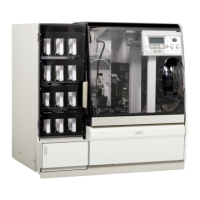Revised 3/30/2010 6.3
Actions to Take upon Generation
of Errors, Cautions, and
Warnings
When an error occurs, an alarm will sound
immediately to alert the operator of the abnormality. If
coverslipping is still possible, the system will wait until the
current process is completed and then display the error
screen. Do not touch the system until the error screen
appears.
Representative message screens that will appear
upon generation of various errors are shown below.
Follow the message on the screen to perform up to four
steps, remove the slides handled in the current process,
and then reset the error.
1. When the error screen below appears (Figure 6-A),
be sure to remove all slides on the transfer stage and
then press the ENTER key. Store the removed slides
in a manner preventing them from drying up, and
process them together later on. The removed slides
cannot be returned to the baskets in the loading
station.
Figure 6-A
2. When the error screen shown below appears (Figure
6-B), press the ENTER key. If the arm is currently
gripping a slide, pull out the slide before pressing the
ENTER key. Store the removed slides in a manner
preventing them from drying up, and process them
together later on. If the arm failed to grip a slide,
press the ENTER key immediately.
Figure 6-B
3. When the error screen shown below appears (Figure
6-C), retain the cover glass currently being picked up
by the suction pads and then press the ENTER key.
The cover glass will be released the moment the
ENTER key is pressed.
Figure 6-C
4. When the error screen below appears (Figure 6-D),
remove receiving rack from rods by lifting upward to
unhook it. Then press the ENTER key.
Figure 6-D
• When slides are in the receiving rack, open the
cover, and carefully remove the receiving rack by
raising the rack upward and tilting the rack back
towards the left as it is being pulled out so that
the slides do not drop out.
• When a rack is being retrieved or unloaded
(when racks are in the unloading area) remove
from the area number indicated on screen or
visually associated with the position of the rods
attached to the robotic arm.
• If rack is still hooked on to the rods, unhook the
rack by lifting upward and tilting the rack slightly
back to the left so that the slides do not fall out.
• It might be necessary to reach behind the
receiving area to remove a rack hooked onto the
rods.

